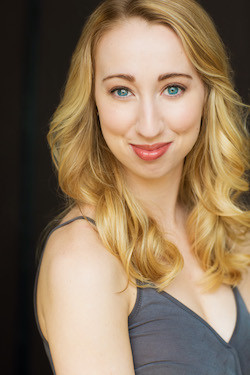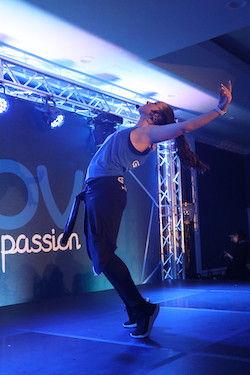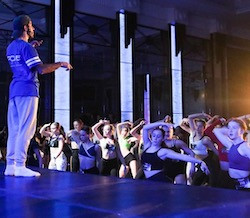It’s officially fall, and while many associate the season with vibrant foliage and pumpkin spice, dancers might find another meaning in the word “fall”—one that brings a touch of dread. The fear of a literal fall, a stumble, or a slip on stage is a common anxiety for dancers of all ages and levels. The pressure to perform flawlessly can be immense, and missteps, whether forgetting choreography, losing synchronization, or, the ultimate dancer’s nightmare, taking a spill center stage, can feel devastating in the moment.
Dancers are often their own harshest critics. The frustration after a performance mishap can be overwhelming. However, the real test lies not in avoiding mistakes, but in how dancers navigate and recover from them. It’s about transforming disappointment into a valuable learning experience and maintaining a positive trajectory in their dance journey.
To shed light on this universal dancer experience, we’ve consulted with judges and teachers from Groove Dance Competition and Convention, seasoned professionals who have witnessed countless performances and understand the pressures dancers face. They share their own experiences with stage mishaps and offer invaluable advice on how dancers can rebound from those disheartening moments and emerge stronger.
Have you ever experienced a fall during performances, competitions, or important auditions?
Mallory Swanick, a judge and convention teacher for Groove Dance Competition and Convention:
“I recall two stage falls vividly. One occurred during a contemporary pointe performance. It was the opening piece of the evening, and the Marley floor had just been cleaned. My choreography included a slide from stage right to stage left en pointe. I slid perfectly onto a section of the stage that was still slightly damp. My supporting knee likely hit the floor, but it happened so fast I barely registered it. I just continued with the remaining 15 minutes of the piece, thankfully laughed it off with my choreographer, and now, I meticulously examine the stage before performing. The second fall was from my competitive dance days. I was performing a solo and realized mid-aerial that my transition into the aerial was off. It unintentionally became an aerial to my knee. To this day, neither my choreographer nor I know how I managed to get back up. I remember being upset, not about the fall itself, but because I didn’t consciously decide how to recover to a standing position in that moment. Needless to say, I practiced that transition extensively the following week.”
 Mallory Swanick, Groove Dance Competition judge and convention teacher, shares her experience with stage falls and emphasizes learning from mistakes.
Mallory Swanick, Groove Dance Competition judge and convention teacher, shares her experience with stage falls and emphasizes learning from mistakes.
Emma Gassett, a dance educator and choreographer:
“While performing with the American Spirit Dance Company at Oklahoma City University, I fell out of an aerial during a performance. I remember my left foot slipping as I lunged into a side aerial, and thinking, ‘My momentum is off! I’m going down!’ Seconds later, I felt a sharp pain as my right shin and kneecap hit the floor. It was a truly humbling moment. I felt immense shame for falling out of an acrobatic trick I’d performed countless times, especially as a professional dancer performing for an audience. But as they say, the show must go on. I picked myself up and continued dancing until the end of the number!”
 Emma Gassett, dance educator and choreographer, recounts a humbling fall during a professional performance, highlighting resilience and the importance of continuing despite mishaps.
Emma Gassett, dance educator and choreographer, recounts a humbling fall during a professional performance, highlighting resilience and the importance of continuing despite mishaps.
Anthony Raimondi, faculty member and judge for Groove Dance Competition and Convention:
“Like any live performer, I’ve had my share of random spills on stage, though none particularly memorable. However, I vividly recall an incident with another performer when I was dance captain for the National Tour of West Side Story. During ‘Cool,’ the Jets’ big dance number, as everyone traveled downstage in unison, she tripped over an upstage ground row. Being in the last line and hidden behind the set piece, she waited until the group returned upstage, then popped up just in time to rejoin for the next phrase. It was a split-second, intelligent decision that ensured no one noticed her fall. I remember it so clearly because of her incredibly smart recovery.”
 Anthony Raimondi, Groove Dance Competition judge and faculty member, shares an anecdote of a performer's clever recovery from a fall, emphasizing the importance of adaptability.
Anthony Raimondi, Groove Dance Competition judge and faculty member, shares an anecdote of a performer's clever recovery from a fall, emphasizing the importance of adaptability.
Have you ever lost time or sync with your group during a performance?
Raimondi:
“Countless times. In the moment, you feel exposed and vulnerable, convinced all eyes are on you. But in reality, the audience rarely knows what’s precisely correct or not.”
Swanick:
“I’m sure I’ve been out of sync more often than I realize, but specific performance moments escape me. Dancers generally sense when the group timing is off, but often underestimate the extent until reviewing performance footage post-show. I have many backstage memories of groups singing counts, reviewing count-altering changes, and reciting counts and corrections to teammates right before stepping onto the stage.”
Gassett:
“Once, during a lyrical group routine titled ‘Tribute to Our Heroes’ at a dance competition when I was about 10, my mind blanked. Time seemed to freeze for me while my fellow dancers continued. My teammates transitioned to a new formation, and I had no idea where to move, despite countless rehearsals. Panic set in. Then, I took a deep breath on stage, observed where the others had moved, and discreetly joined the formation as quickly as possible. I kept telling myself to stay calm and get back in sync.”
 Mallory Swanick, judge at Groove Dance Competition and Convention, offers advice on recovering from stage mistakes, highlighting the value of the learning process.
Mallory Swanick, judge at Groove Dance Competition and Convention, offers advice on recovering from stage mistakes, highlighting the value of the learning process.
It’s easy for dancers to be self-critical after mistakes. What advice do you offer for recovering emotionally from stage mishaps?
Swanick:
“While falls or mistakes can be momentarily discouraging, they don’t define you as a dancer. Performances are the culmination of your artistic efforts, but the journey leading up to them—your work ethic, focus, vulnerability, and passion—holds immense value. If the process was rewarding and the stage time (minus that split-second hiccup) was fulfilling, consider it a success. Learning from the experience is an added bonus!”
Gassett:
“Life throws curveballs, even on stage. We can’t control these moments, but we control our response. Remember to breathe deeply to clear your head after a fall or choreography error. Despite striving for perfection, mishaps happen. Acknowledge that they build resilience, knowledge, and determination. We are human; mistakes are okay.”
Raimondi:
“Don’t dwell on mistakes; they can undermine your performance. Dancers are trained for perfection, driving studio dedication, but live theater is inherently imperfect. Falls and errors occur, but recovery is what truly matters. The West Side Story dancer stood out not for falling, but for her intelligent, swift, and composed recovery.”
As a judge at Groove Dance Competition, how do you assess a dancer’s fall or mistake? Do you deduct points or offer constructive feedback?
Raimondi:
“I rarely deduct points for falls or mistakes. I acknowledge them, perhaps explain potential causes and offer preventative advice for future performances, but never penalize with point deductions. Performers must learn that the show typically continues regardless, and resilience is key. Recovering from such moments showcases a performer’s true capability, which I view positively in scoring.”
 Anthony Raimondi, judge for Groove Competition and Convention, explains his judging philosophy, focusing on recovery and learning from mistakes rather than penalizing them.
Anthony Raimondi, judge for Groove Competition and Convention, explains his judging philosophy, focusing on recovery and learning from mistakes rather than penalizing them.
Swanick:
“Recovery is paramount. I don’t negatively focus on falls or missteps; dancers are constantly training, and errors happen. I offer feedback to prevent future occurrences, often pointing out misuse of energy, force, or technical flaws in transitions. If recovery is quick and the dancer continues seamlessly, I commend them. If injury necessitates stage exit, I praise their safe decision and offer encouragement.”
Gassett:
“If a dancer falls, I advise them to get up and continue unless injured. Never compromise health for a routine. For severe pain after a fall or mistake, exit or remain still until help arrives. I never deduct points for falls; anything can happen live. I encourage dancers to maintain full energy unless seriously injured.”
How can dancers transform stage mishaps into positive learning experiences?
Raimondi:
“Self-correction is crucial. Review performance videos, analyze mistakes, and be open to correction. Watch as a judge, identifying areas for improvement. This develops the ability to self-correct in real-time and become a performer who recovers quickly and intelligently.”
Swanick:
“See falls or mistakes as challenges. A choreographer once challenged me to intentionally fall out of pirouettes, but never in the same direction twice. With 360 degrees of rotation, there were 360 potential fall directions, each fall teaching correction. The goal: understand what falling in every direction feels like, thus understanding perfect vertical alignment and center of gravity. While mastering 360 pirouette falls is ongoing, the challenge reminds me that falls aren’t shameful. They inspire new approaches to improvement. Each fall is a step closer to your goal.”
Gassett:
“Channel post-mistake frustration into training fuel. Rehearse the problematic section repeatedly. Cross-train to strengthen relevant muscle groups. Remember, everyone errs. You’re not alone. Move forward, choosing a positive response! When life gives you lemons, make lemonade! If you stumble on stage, keep dancing! Often, the audience or judges won’t even notice. Don’t let frustration show or diminish your energy. Persevere and finish strong!”
By incorporating advice from Groove Dance Competition experts, dancers can learn to navigate stage mishaps with grace, resilience, and a growth mindset. Turning falls and mistakes into opportunities for learning and improvement is essential for a successful and fulfilling dance journey.

